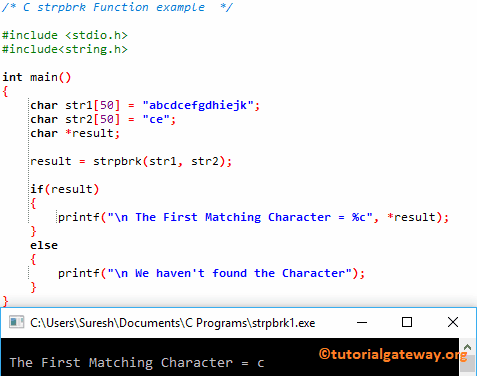The C strpbrk function is a String Function, which is used to find the first character in a first string that matches any character in a second string. The syntax of the strpbrk in C Programming language is
char *strpbrk(const char *str1, const char *str2);
or we can simply write strpbrk as:
strpbrk(str1, str2);
strpbrk in C language Example
This program will help you to understand the strpbrk with multiple examples.
You must include the #include<string.h> header before using this strpbrk String Function.
#include <stdio.h>
#include<string.h>
int main()
{
char str1[50] = "abcdcefgdhiejk";
char str2[50] = "ce";
char *result;
result = strpbrk(str1, str2);
if(result)
{
printf("\n The First Matching Character = %c", *result);
}
else
{
printf("\n We haven't found the Character");
}
}

strpbrk in C Example 2
Instead of predefining the two strings, this C program allows the user to enter string 1 and string 2. Next, C Program will find the first records from string 1 that matches any character in string 2
#include <stdio.h>
#include<string.h>
int main()
{
char str1[50], str2[50];
char *result;
printf("\n Please Enter any String : ");
gets(str1);
printf("\n Please Enter the String that you want to Match : ");
gets(str2);
result = strpbrk(str1, str2);
if(result)
{
printf("\n The First Matching Character = %c", *result);
}
else
{
printf("\n We haven't found the Character");
}
}
Please Enter any String : tutorial gateway inside
Please Enter the String that you want to Match : dyle
The First Matching Character = lAlthough all the four characters in the second string exist in str1, It returned the output as l. It is because l is the first occurrence letter in string 1 compared to e y d
